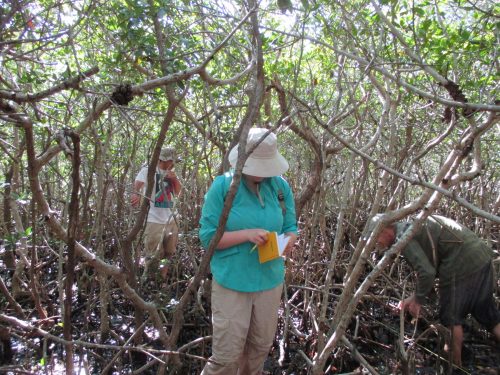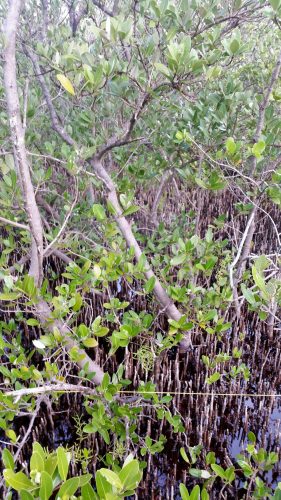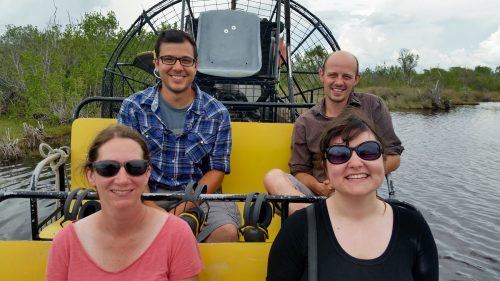In the September (2015) newsletter, we announced a new project supported by the National Science Foundation. In June, field work led by Jennifer Haney, a doctoral candidate from the Pennsylvania State University, began the first phase of that research.
Jen and three undergraduate students (Matt Veres, Patrick Condon, and Chandler Snow), also from Penn State, were hosted at the Randell Research Center’s office and headquarters building, the Ruby Gill House at Pineland.

The summer investigation was part of the broader paleoethnobotanical work, the study of plant and people interactions through time in Southwest Florida. The focus of this particular research trip, however, was not to dig up the past but to document one legacy of the past: Pine Island’s present-day mangrove forests.
Information about Pine Island’s modern mangrove species, densities, diameters, and deadwood volume will provide the end point of a high-resolution record of fuelwood availability. Constructing backward from this modern end point, archaeological charcoal data will then be used to create a timeline that illustrates changes to the ancient coastal forests through time.
Once established, this long-term forest record will provide information with which archaeologists can study sustainability and how the management of natural resources might play a role in the development of social complexity. Given that the Calusa were a complex, stratified society without a reliance on agriculture, what might have allowed leaders to remain in power? If the leaders were not organizing the growing, storage, and distribution of agricultural resources, then could they have been directing the use and management of other resources?

For the Calusa, wood would have been the main source of fuel for cooking and smoking food. Jennifer posits that control/ management of fuelwood may have played a role in the development of social inequality within the Calusa culture. As pre-contact population levels rose, fuelwood may have become a critical and increasingly scarce resource.
The research team was granted permission to access several forest preserves by the Florida Department of Environmental Protection, the Lee County Parks and Recreation Conservation 20/20 Program, the Calusa Land Trust, and the Randell Research Center. Sampling locations were chosen randomly within the accessible preserves to represent the variability seen at near-shore and inland ecological zones. The team’s method of data recording was adapted from that used by the US Forest Service in their statewide Forest Inventory and Analysis Program. Each sampling plot consisted of a circle with a diameter of 48 feet. Within that circle, the team counted every tree, noting its type, number of trunks, and the diameter of each. If the tree had only a single trunk, then a minimum and maximum branch size was also recorded. Three transects were also walked, within the circle, to count the amount of fallen deadwood and measure its diameter. Finally, a count was taken in a smaller sub-plot area to record the number of saplings, which ranged from seedlings up to young trees with diameters less than one inch.

We would like to thank everyone who contributed to the success of our recent research trip. Many gave freely of their time and resources. In particular we would like to thank the Randell Research Center staff and volunteers for providing a home away from home. We would also thank the staff at the Lee County Parks and Recreation Office, especially Ranger M. Miller, for assisting the crew in the field and helping us to navigate parcel access and gates. Finally, we wish to thank the Calusa Land Trust members for their enthusiasm and many offers of assistance. On a more personal note, the whole research team appreciated Cindy Bear’s gift of delicious, fresh mangos.
An additional sampling trip was undertaken in November by Jennifer Haney, and another is planned for April 2016. It will focus on Calusa Land Trust preserves, off shore mangrove keys, and portions of the barrier islands.
This article was taken from the Friends of the Randell Research Center Newsletter Vol 14, No. 4. December 2015.